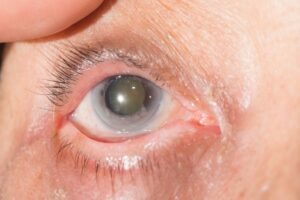If you have been told by your doctor that you have a sclerotic cataract, you may be wondering what that means. A sclerotic cataract is a type of cataract that is caused by the hardening of the lens in the eye. This can make it difficult for light to pass through the lens and result in a decrease in vision. In this blog post, we will discuss what causes sclerotic cataracts, how it is treated, and what to expect after treatment.
Contents
What Is Sclerotic Cataract?
 A sclerotic cataract is also known as a posterior subcapsular cataract. It is a type of cataract that develops behind the lens capsule and is caused by aging or prolonged exposure to UV light. This is one of the most common types of cataracts that begins with the hardening and yellowing of the lens tissue, leading to blurry vision.
A sclerotic cataract is also known as a posterior subcapsular cataract. It is a type of cataract that develops behind the lens capsule and is caused by aging or prolonged exposure to UV light. This is one of the most common types of cataracts that begins with the hardening and yellowing of the lens tissue, leading to blurry vision.
Many people with this cataract may notice that their vision is gradually blurred and they can also experience glare and halos around light sources. If you are concerned that you may have a sclerotic cataract, it is important to schedule an eye exam with your optometrist or ophthalmologist as soon as possible.
What Are The Symptoms?
There are several signs and symptoms of sclerotic cataracts that can help distinguish it from other types of cataracts. These include:
- Reduce vision in bright light: This is the most common symptom of sclerotic cataracts. It can be difficult to see in bright light, such as outdoors on a sunny day or when driving at night.
- Halos around lights: This is when you see rings or halos of light around headlights and other bright lights. These halos can blur your vision, making it more difficult to focus on the task at hand.
- Sensitivity to glare: This can make it difficult for you to drive or look out of windows at night, as bright headlights and other lights can cause a great deal of discomfort.
- Increased nearsightedness: It is common to experience a gradual increase in nearsightedness with sclerotic cataracts.
- Clouding of the lens: Some sclerotic cataracts eventually cause a clouding of the lens. This can lead to blurring and distortion in your vision, making it difficult to see clearly at all distances.
So, these symptoms can help to distinguish sclerotic cataracts from other types of cataracts. It is important to discuss any changes in your vision with your healthcare provider and get a proper diagnosis before beginning treatment. This will help ensure that you get the best possible care.
What Causes Sclerotic Cataracts?
There are many potential causes of a sclerotic cataract, but the most common is a genetic mutation. Other potential causes are:
- Exposure to ultraviolet light
- Radiation therapy
- Certain medications
- Diseases such as diabetes or glaucoma
Although the condition is more common in humans, it is possible for animals such as cats and dogs to develop sclerotic cataracts. The reason behind this is simply the process of getting older.
More often than not, sclerotic cataracts tend to be a sign of advancing age. It is believed that the aging process causes the lens of the eye to thicken, causing light to scatter and blur vision.
How Is It Diagnosed?
The diagnosis of a sclerotic cataract usually involves an eye examination. Your eye doctor will look into the lens of your eye with a slit lamp and may take a photograph of the lens to evaluate it more closely. They may also measure your vision and examine the iris and the angle between your pupil and iris.
If a sclerotic cataract is suspected, your doctor may order specialized tests to confirm and pinpoint the location of the cataract. Other tests that may be ordered include:
- Refraction test
- Ocular coherence tomography (OCT)
- Ultrasound
An accurate diagnosis can help your doctor determine the best treatment options for you. You should always understand the risks and benefits of any treatment before deciding which is right for you.
How Is It Treated?
 The most common treatment option for sclerotic cataracts is surgery. Surgery involves removing the affected lens and replacing it with a new artificial intraocular lens (IOL). In some cases, your doctor may also need to remove any scar tissue present in order to improve the outcome.
The most common treatment option for sclerotic cataracts is surgery. Surgery involves removing the affected lens and replacing it with a new artificial intraocular lens (IOL). In some cases, your doctor may also need to remove any scar tissue present in order to improve the outcome.
In most cases, sclerotic cataracts are treated with a single procedure and do not require additional treatments or medications. After surgery, you may need to wear corrective lenses to help improve your vision.
Your doctor may also recommend lifestyle changes like quitting smoking, eating healthy foods, and exercising regularly in order to improve the condition. It is important to follow your doctor’s instructions carefully so that you can have the best outcome possible.
In some cases, doctors may also recommend medications such as corticosteroids or NSAIDs (non-steroidal anti-inflammatory drugs) to reduce inflammation and pain associated with cataracts. These medications can also help slow the progression of the cataract or may even reverse it in some cases.
Overall, sclerotic cataracts are a treatable condition that can be effectively managed with the right treatment plan and lifestyle modifications. Your doctor will work with you to develop a plan that works best for you and your individual needs. With proper care, it is possible to reduce the symptoms of sclerotic cataracts and improve your vision.
Does Sclerosis Cause Blindness?
It is often assumed that sclerotic cataract is a cause of blindness, but it’s not necessarily so. Sclerotic cataracts are caused by the thickening and hardening of the lens of your eye, which can lead to vision impairment or even complete vision loss.
However, not all people who have sclerotic cataracts will become blind. In fact, most people with this condition can still see clearly enough to perform everyday tasks and activities. This happens because this condition often progresses very slowly. And gives your eye enough time to adapt to the changes and adjust accordingly.
Therefore, if you are someone with a sclerotic cataract, you may still be able to see clearly enough and be able to live a normal life. And in severe cases, do not forget to seek medical attention in order to have the cataract surgically removed.
Conclusion
In conclusion, a sclerotic cataract may be a rare form of cataract and is likely to cause significant vision loss. It is important to seek medical advice when symptoms of sclerotic cataracts appear, as timely diagnosis and treatment may preserve sight. Treatment options include intraocular lens surgery, laser procedures, or other types of surgery depending on the severity of the condition.
In any case, be sure to consult with your doctor when seeking treatment for sclerotic cataracts. And keep regular visits with your ophthalmologist in order to monitor the progress of the condition. With adequate care, those suffering from sclerotic cataracts can maintain their sight and enjoy a better quality of life.
Cataract surgery is a safe and painless procedure. At MantraCare we have a team of experienced eye surgeons, who will be happy to answer any questions on cataract surgery. Call us at +91-9711116605 for any inquiries.
